Passion of Jesus: Difference between revisions
m fix nested small tag |
Macslacker (talk | contribs) →The Passion according to the Gospels: linked to the proper page |
||
| Line 59: | Line 59: | ||
John records that Mary, his mother, and two other women stood by the cross as did a disciple, described as [[Disciple whom Jesus loved|the one whom Jesus loved]]. Jesus committed his mother to this disciple's care. According to the synoptics, the [[Crucifixion eclipse|sky became dark at midday]] and the darkness lasted for three hours, until the ninth hour when Jesus cried out ''Eloi, Eloi, lama sabachthani?'' (''My God, why have you forsaken me?'')<ref>Mark reports Jesus said ''Eloi, Eloi, lama sabachthani?'' in [[Aramaic]]; Matthew reports ''Eli, Eli....''</ref> The centurion standing guard, who had seen how Jesus died, declared Jesus innocent (Luke) or ''Son of God'' (Matthew, Mark). |
John records that Mary, his mother, and two other women stood by the cross as did a disciple, described as [[Disciple whom Jesus loved|the one whom Jesus loved]]. Jesus committed his mother to this disciple's care. According to the synoptics, the [[Crucifixion eclipse|sky became dark at midday]] and the darkness lasted for three hours, until the ninth hour when Jesus cried out ''Eloi, Eloi, lama sabachthani?'' (''My God, why have you forsaken me?'')<ref>Mark reports Jesus said ''Eloi, Eloi, lama sabachthani?'' in [[Aramaic]]; Matthew reports ''Eli, Eli....''</ref> The centurion standing guard, who had seen how Jesus died, declared Jesus innocent (Luke) or ''Son of God'' (Matthew, Mark). |
||
John also says that, as was the custom, the soldiers came and broke the legs of the thieves, so that they would die faster, but that on coming to Jesus they found he had already died. A soldier pierced his side with a [[spear]]. |
John also says that, as was the custom, the soldiers came and broke the legs of the thieves, so that they would die faster, but that on coming to Jesus they found he had already died. A soldier pierced his side with a [[Holy Lance|spear]]. |
||
The various words of Jesus during the ''Crucifixion'' are collected from the different Gospel accounts as the ''[[Last Words of Christ]].'' |
The various words of Jesus during the ''Crucifixion'' are collected from the different Gospel accounts as the ''[[Last Words of Christ]].'' |
||
Revision as of 01:05, 3 October 2011

| Part of a series on |
| Death and Resurrection of Jesus |
|---|
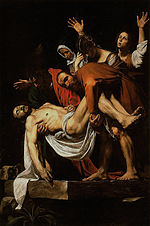 |
|
Portals: |
| Events in the |
| Life of Jesus according to the canonical gospels |
|---|
 |
|
Portals: |
The Passion is the Christian theological term used for the events and suffering – physical, spiritual, and mental – of Jesus in the hours before and including his trial and execution by crucifixion. The Crucifixion of Jesus is an event central to Christian beliefs.
The etymological origins of the word lie in the Greek verb paschō, to suffer,[1] from passages such as Matthew17:12 (and parallel passages in Mark and Luke) and Acts 1:3. The Latin word passio[2] is used with reference to Christ's mortal suffering in the Vulgate. The term first appears in 2nd century Christian texts precisely to describe the travails and suffering of Jesus in this present context. The word passion has since taken on a more general application and now also describes the accounts of Christian martyrs.
The term the Agony of Jesus is more specifically applied to the Agony in the Garden, Jesus' action (Greek agon) praying before his arrest in the Garden of Gethsemane; similarly to passion, agony has been extended to denote a frame of mind.
Those parts of the four Gospels that describe these events are known as the "Passion narratives". The non-canonical Gospel of Peter is also a Passion narrative. In the liturgical calendar, the Passion is commemorated in Holy Week, beginning on Palm Sunday and ending on Easter Saturday.
The Passion according to the Gospels

The accounts of the Passion are found in the four canonical gospels, Matthew, Mark, Luke and John. Three of these, Matthew, Mark, and Luke, known as the Synoptic Gospels, give very similar accounts. The Gospel of John includes additional details.
The Passion begins at Matthew 26, Mark 14, Luke 22 and John 12 with the conspiracy against Jesus by the Jewish chief priests and the teachers of the law,[3][4][5] and unfolds in the following events:
A meal a few days before Passover. A woman anoints Jesus. He says that for this she will always be remembered.
In Jerusalem, the Last Supper shared by Jesus and his disciples. Jesus gives final instructions, predicts his betrayal, and tells them all to remember him.
On the path to Gethsemane after the meal. Jesus tells them they will all fall away that night; after Peter protests he will not, Jesus says Peter will deny him three times before the cock crows.
Gethsemane, later that night. As the disciples rest, Jesus prays; then Judas Iscariot leads in either "a detachment of soldiers and some officials from the chief priests and Pharisees"[6] (accompanied according to Luke's Gospel by the chief priests and elders),[7] or a "large crowd armed with swords and clubs, sent from the chief priests and elders of the people",[8][9] which arrests Jesus; all his disciples run away.
The high priest's palace, later that night. The arresting party brings Jesus to the Sanhedrin (Jewish supreme court); according to Luke's Gospel, Jesus is beaten up by his Jewish guards prior to his examination;[10] the court examines him, in the course of which, according to John's Gospel, Jesus is struck in the face by one of the Jewish officials;[11] the court determine he deserves to die (see Sanhedrin Trial of Jesus). According to Matthew's Gospel, the court then "spat in his face and struck him with their fists".[12] They then send him to Pontius Pilate.
The courtyard outside the high priest's palace, the same time. Peter has followed Jesus and joined the mob awaiting Jesus’ fate; they suspect he is a sympathizer, so Peter denies he knows Jesus. Suddenly the cock crows and Peter remembers what Jesus had said.
The governor's palace, early morning. Pilate, the Roman governor, examines Jesus, decides he is innocent; the Jewish leaders and the crowd demand Jesus’ death; Pilate gives them the choice of saving Barabbas, a criminal, or saving Jesus. In response to the screaming mob Pilate sends Jesus out to be crucified. According to the Gospel of Matthew, Judas, the betrayer, is filled with remorse and tries to return the money he was paid for betraying Jesus. When the high priests say that that is his affair, Judas throws the money into the temple, goes off, and hangs himself.[13]
Golgotha, a hill outside Jerusalem, later morning through mid afternoon. Jesus is crucified and dies.
During the arrest in Gethsemane, someone (Peter according to John) takes a sword and cuts off the ear of the high priest's servant, Malchus. According to the synoptic gospels, the high priest who examines Jesus is Caiaphas; in John, Jesus is also interrogated by Annas, Caiaiphas' father-in-law.
The Gospel of Luke states that Pilate sent Jesus to be judged by Herod Antipas because as a Galilean he was under his jurisdiction. Herod was excited at first to see Jesus and hoped Jesus would perform a miracle for him and asked Jesus several questions but Jesus did not answer. Herod then mocked him and sent him back to Pilate after giving him an "elegant" robe to wear.[14]
All the Gospels have a man named Barabbas[15] released by Pilate instead of Jesus. Matthew, Mark and John have Pilate offer a choice between Jesus and Barabbas to the crowd; Luke lists no choice offered by Pilate, but represents the crowd demanding his release.
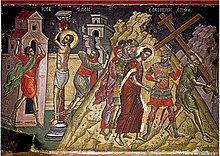
In all the Gospels, Pilate asks Jesus if he is King of the Jews and Jesus replies So you say. Once condemned by Pilate, he was flogged before execution. The Canonical Gospels, except Luke, record that Jesus was then taken by the soldiers to the Praetorium where, according to Matthew and Mark, the whole contingent of soldiers was called together. They placed a purple robe on him, put a crown of thorns on his head, and according to Matthew, put a rod in his hand. They mocked him by hailing him as King of the Jews, paying homage and hitting him on the head with the rod.
According to the Gospel of John, Pilate had Jesus brought out a second time, wearing the purple robe and the crown of thorns, in order to appeal his innocence before the crowd, saying "Ecce homo", "Behold the man". But, John represents, the priests urged the crowd to demand Jesus' death. Pilate resigned himself to the decision, washing his hands (according to Matthew) before the people as a sign that Jesus' blood would not be upon him.
Mark and Matthew record that Jesus was returned his own clothes, prior to being led out for execution. According to the Gospel accounts he was forced, like other victims of crucifixion, to drag his own cross to Golgotha,[16] the location of the execution. The three Synoptic Gospels refer to a man called Simon of Cyrene who is made to carry the cross (Mark 15:21, Matthew 27:32, Luke 23:26), while in the Gospel of John (19:17) Jesus is made to carry His own cross. The Gospel of Mark gives the names of Simon's children, Alexander and Rufus. However, the Gospel of Luke refers to Simon carrying the cross after Jesus, in that it states: "they laid hold upon one Simon, a Cyrenian, coming out of the country, and on him they laid the cross, that he might bear it after Jesus".[17] Luke adds that Jesus' female followers were following him, and mourning his fate, but that he responded by quoting Hosea 10:8.

The Synoptic Gospels state that on arrival at Golgotha, Jesus was offered wine laced with myrrh to lessen the pain, but he refused it. Jesus was then crucified, according to Mark, at the third hour (9 AM) the morning after the Passover meal, but according to John he was handed over to be crucified at the sixth hour (noon) the day before the Passover meal, though many resolve this by saying that the Synoptics use Jewish time, and that John uses Roman time. Pilate had a plaque fixed to Jesus' cross inscribed, (according to John) in Hebrew, Greek and the Latin - Iesu Nazarenus Rex Iudeorum,[18] meaning Jesus of Nazareth, King of the Jews. Mark has the plaque say simply, King of the Jews. The Gospels then state that they divided Jesus' clothes between the soldiers except for one garment for which they cast lots. The Gospel of John claims that this fulfills a prophecy from Psalms 22:18. Some of the crowd who had been following taunted Jesus, saying "He trusts in God; let God deliver him now!", and suggested that Jesus might perform a miracle to release himself from the cross.
According to the Gospels, two thieves were also crucified, one on each side of him. According to Luke, one of the thieves reviled Jesus, while the other declared Jesus innocent and begged that he might be remembered when Jesus came to his kingdom (see Saint Dismas).
John records that Mary, his mother, and two other women stood by the cross as did a disciple, described as the one whom Jesus loved. Jesus committed his mother to this disciple's care. According to the synoptics, the sky became dark at midday and the darkness lasted for three hours, until the ninth hour when Jesus cried out Eloi, Eloi, lama sabachthani? (My God, why have you forsaken me?)[19] The centurion standing guard, who had seen how Jesus died, declared Jesus innocent (Luke) or Son of God (Matthew, Mark).
John also says that, as was the custom, the soldiers came and broke the legs of the thieves, so that they would die faster, but that on coming to Jesus they found he had already died. A soldier pierced his side with a spear.
The various words of Jesus during the Crucifixion are collected from the different Gospel accounts as the Last Words of Christ.
The Gospel of Peter
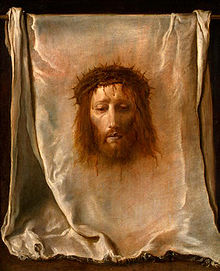
Further claims concerning the Passion are made in some non-canonical early writings. Another passion narrative is found in the fragmentary Gospel of Peter, long known to scholars through references, and of which a fragment was discovered in Cairo in 1884.
The narrative begins with Pilate washing his hands, as in Matthew, but the Jews and Herod refuse this. Joseph of Arimathea, before Jesus has been crucified, asks for his body, and Herod says he was going to take it down to comply with the Jewish custom of not leaving a dead body hung on a tree overnight. Herod then turns Jesus over the people, who drag him, give him the purple robe, crown him with thorns, and beat and flog him.
There are also two criminals on each side of him and, as in Luke, one begs Jesus for forgiveness. The writer says Jesus was silent as they crucified him, "...as if in no pain." [20] Jesus is labeled the King of Israel on his cross and his clothes are divided and gambled over.
As in the canonical Gospels, darkness covers the land. Jesus is also given vinegar to drink. Peter has "My Power, My Power, why have you forsaken me?" as the last words of Jesus, rather than "My God, My God, why have you forsaken me?" as quoted in Mark. He is then "taken up", possibly a euphemism for death or maybe an allusion to heaven.[21] Peter then has a resurrection, also somewhat the same but somewhat different from the other books.
Serapion of Antioch urged the exclusion of the Gospel of Peter from the Church because Docetists were using it to bolster their theological claims, which Serapion rejected.[22] Many modern scholars also reject this conclusion, as the statement about Jesus being silent "as if in no pain" seems to be based on Isaiah's description of the suffering servant, "as a sheep that before its shearers is silent, so he opened not his mouth." (Isaiah 53:7).[21]
Old Testament prophecy of the Passion
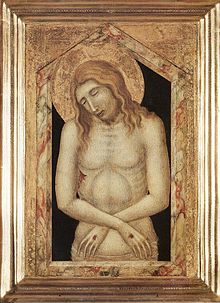
Christians interpret at least three passages of the Old Testament as prophecies about Jesus’ Passion.
The first and most obvious is the one from Isaiah 52:13–53:12 (either 8th or 6th century BC). This prophetic oracle describes a sinless man who will atone for the sins of his people. By his voluntary suffering, he will save sinners from the just punishment of God. The death of Jesus is said to fulfil this prophecy. E.g., "He had no form or comeliness that we should look at him, and no beauty that we should desire him. He was despised and rejected by men; a man of sorrows, and acquainted with grief; and as one from whom men hide their faces he was despised, and we esteemed him not. Surely he has borne our griefs and carried our sorrows; yet we esteemed him stricken, smitten by God, and afflicted. But he was wounded for our transgressions, he was bruised for our iniquities; upon him was the chastisement that made us whole, and with his stripes we are healed" (53:2–5).
The second prophecy of Christ's Passion is the ancient text which Jesus himself quoted, while he was dying on the cross. From the cross, Jesus cried with a loud voice, Eli, Eli, lema sabachthani? which means, "My God, my God, why hast Thou forsaken me?" These words of Jesus were a quotation of the ancient HE. King David, in Psalm 22, foretold the sufferings of the messiah. E.g., "I am a worm and no man, the reproach of men and the outcast of the people. All who see me, laugh me to scorn, they draw apart their lips, and wag their heads: ‘He trusts in the Lord: let him free him, let him deliver him if he loves him.’ Stand not far from me, for I am troubled; be thou near at hand: for I have no helper… Yea, dogs are round about me; a company of evildoers encircle me; they have pierced my hands and feet – I can count all my bones – they stare and gloat over me; they divide my garments among them, and for my raiment they cast lots" (Psalm 22:7–19). The words "they have pierced my hands and feet" are disputed, however.
The third main prophecy of the Passion is from the Book of the Wisdom of Solomon. Protestant Christians place it in the Apocrypha, Roman Catholics and Eastern Orthodox among the deuterocanonical books. But it was written about 150 BC, and many have understood these verses (12-20 of chapter 2) as a direct prophecy of Jesus’ Passion. E.g., "Let us lie in wait for the just, because he is not for our turn… He boasteth that he hath the knowledge of God, and calleth himself the son of God…and glorieth that he hath God for his father. Let us see then if his words be true… For if he be the true son of God, he will defend him, and will deliver him from the hands of his enemies. Let us examine him by outrages and tortures… Let us condemn him to a most shameful death … These things they thought, and were deceived, for their own malice blinded them" (Wisdom 2:12-20).
In addition to the above, it deserves to be mentioned that at least three other, less elaborate messianic prophecies were fulfilled in Jesus’ crucifixion. Namely, the following Old Testament passages.
"Many are the afflictions of the just man; but the Lord delivers him from all of them. He guards all his bones: not even one of them shall be broken" (Psalm 34:20).
"And they gave me gall for my food, and in my thirst they gave me vinegar to drink" (Psalm 69:21).
"And they shall look upon me whom they have pierced; and they shall mourn for him as one mourneth for an only son; and they shall grieve over him, as the manner is to grieve for the death of the firstborn" (Zechariah 12:10).
New Testament prophecy of the Passion

The Gospel explains how these old prophecies were fulfilled in Jesus’ crucifixion.
"So the soldiers came and broke the legs of the first, and of the other who had been crucified with Jesus; but when they came to Jesus and saw that he was already dead, they did not break his legs. But one of the soldiers pierced his side with a spear, and at once there came out blood and water… For these things took place that the scripture might be fulfilled, ‘Not a bone of him shall be broken.’ And again another scripture says, ‘They shall look on him whom they have pierced’" (John 19:32–37).
In the Gospel of Mark, Jesus is described as prophesying his own Passion and his Resurrection three times:
- On the way to Caesarea Philippi, predicting that the Son of Man will be killed and rise within three days
- After the transfiguration of Jesus, again predicting that the Son of Man will be killed and rise within three days
- On the way to Jerusalem, predicting that the Son of Man will be delivered to the leading Pharisees and Sadducees, be condemned to death, delivered to the Gentiles, mocked, scourged, killed, and rise within three days
Christians argue that these are cases of genuine and fulfilled prophecy and many scholars see semitic features and old tradition in Mark 9:31.[23] Skeptics[who?] argue they are cases of postdiction (prophecy after the events have already occurred).
After the third prophecy, the Gospel of Mark states that the brothers James and John ask Jesus to be his left and right hand men, but Jesus asks if they can drink from the cup he must drink from. They say that they can do this. Jesus confirms this, but say that the places at his right and left hand are reserved for others. Many Christian see this as being a reference to the two criminals at Jesus' crucifixion, thus relating to the Passion. The cup is sometimes interpreted as the symbol of his death, in the light of Jesus' prayer at Gethsemane "Let this cup be taken from me!"
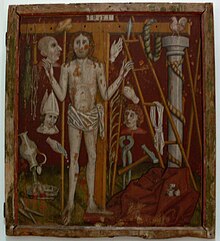
Liturgical use
Holy Week
Most Christian denominations will read one or more narratives of the Passion during Holy Week, especially on Good Friday. In the Roman Catholic church, a large cross depicting the crucified Christ is brought out into the church and each of the faithful come forward to venerate the cross. Rather than having the Gospel read solely by the priest, whole Roman Catholic congregations participate in the reading of the Passion Gospel during the Palm Sunday Mass and the Good Friday service. These readings have the Priest read the part of Christ, a narrator read the narrative, other reader(s) reading the other speaking parts, and either the choir or the congregation reading the parts of crowds (i.e.: when the crowd shouts "Crucify Him! Crucify Him!") [24]
In the Eastern Orthodox and Greek-Catholic Churches, the Matins service for Good Friday is called Matins of the Twelve Passion Gospels, and is remarkable for the interspersing of twelve readings from the Gospel Book detailing chronologically the events of the Passion—from the Last Supper to the burial in the tomb—during the course of the service. The first of these twelve readings is the longest Gospel reading of the entire liturgical year. In addition, every Wednesday and Friday throughout the year is dedicated in part to the commemoration of the Passion.[25]
During Holy Week/Passion Week Congregations of the Moravian Church (Herrnhuter Bruedergemeine) read the entire story of Jesus' final week from a Harmony of the Gospels prepared for that purpose since 1777. Daily meetings are held, some times 2 or 3 times a day, to follow the events of the day. During the course of the reading, the Congregation sings hymn verses to respond to the events of the text.
Most liturgical churches hold some form of commemoration of the Crucifixion on the afternoon of Good Friday. Sometimes, this will take the form of a vigil from noon to 3:00 pm, the approximate time that Jesus hung on the cross. Sometimes there will be a reënactment of the Descent from the Cross; for instance, at Vespers in the Byzantine (Eastern Orthodox and Greek-Catholic) tradition.
Reparation to Jesus

The Roman Catholic tradition includes specific prayers and devotions as acts of reparation for the sufferings and insults that Jesus endured during His Passion. These Acts of Reparation to Jesus Christ do not involve a petition for a living or deceased beneficiary, but aim to repair the sins against Jesus. Some such prayers are provided in the Raccolta Catholic prayer book (approved by a Decree of 1854, and published by the Holy See in 1898) which also includes prayers as Acts of Reparation to the Virgin Mary.[26][27][28][29]
In his encyclical Miserentissimus Redemptor on reparations, Pope Pius XI called Acts of Reparation to Jesus Christ a duty for Catholics and referred to them as "some sort of compensation to be rendered for the injury" with respect to the sufferings of Jesus.[30]
Pope John Paul II referred to Acts of Reparation as the "unceasing effort to stand beside the endless crosses on which the Son of God continues to be crucified".[31]
The Passion in visual art

For a full list of the subjects forming narrative works of art on the Passion, or episodes from it, see Life of Christ. Each episode, such as the Flagellation of Christ or Entombment of Christ, has been represented thousands of times and has developed its own iconographic tradition; the Crucifixion is much the most common and important of these subjects. The Passion is often covered by a cycle of depictions; Albrecht Dürer's print cycles were so popular that he produced three different versions. Andachtsbilder is a term for devotional subjects such as the Man of Sorrows or Pietà that may not precisely represent a moment in the Passion but are derived from the Passion story. The Arma Christi, or "Instruments of the Passion" are the objects associated with Jesus' Passion, such as the cross, the Crown of Thorns and the Spear of Longinus. Each of the major Instruments has been supposedly recovered as relics which have been an object of veneration among many Christians, and have been depicted in art. Veronica's Veil is also often counted among the Instruments of the Passion; like the Shroud of Turin and Sudarium of Oviedo it is a cloth relic supposed to have touched Jesus.
In the Roman Catholic Church (and some Anglo-Catholic and Western Rite Orthodox churches), the Passion story is depicted in the Stations of the Cross (via crucis, also translated more literally as "Way of the Cross"). These 14 stations depict the Passion from the sentencing by Pilate to the sealing of the tomb, and since the 16th century representations of them in various media have decorated the naves of most Catholic churches. The Way of the Cross is a devotion practiced by many people on Fridays throughout the year, most importantly on Good Friday. This may be simply by going round the Stations in a church, or may involve large-scale re-enactments, as in Jerusalem. The Sacri Monti of Piedmont and Lombardy are similar schemes on a far larger scale than church Stations, with chapels containing large sculpted groups arranged in a hilly landscape; for pilgrims to tour the chapels typically takes several hours. They mostly date from the late 16th to the 17th century; most depict the Passion, others different subjects as well.
The Passion in music
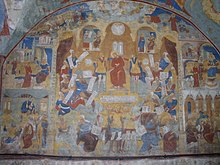
The main traditional types of church music sung during Holy Week are "Passions", musical settings of the Gospel narratives, both a Catholic and Lutheran tradition, and settings of the readings and responses from the Catholic Tenebrae services, especially those of the Lamentations of Jeremiah the Prophet. The many settings of the Stabat Mater or The Seven Last Words of Christ are also commonly performed.
The reading of the Passion section of one of the Gospels during Holy Week dates back to the 4th century. It began to be intoned (rather than just spoken) in the Middle Ages, at least as early as the 8th century. 9th-century manuscripts have "litterae significativae" indicating interpretive chant, and later manuscript begin to specify exact notes to be sung. By the 13th century different singers were used for different characters in the narrative, a practice which became fairly universal by the 15th century, when polyphonic settings of the turba passages began to appear also. (Turba, while literally meaning "crowd", is used in this case to mean any passage in which more than one speaker speak simultaneously.)
In the later 15th century a number of new styles began to emerge:
- Responsorial Passions set all of Christ's words and the turba parts polyphonically
- Through-composed Passions were entirely polyphonic (also called motet Passions). Jacob Obrecht wrote the earliest extant example of this type.
- Summa Passionis settings were a synopsis of all four Gospels, including the Seven Last Words (a text later set by Haydn and Théodore Dubois). These were discouraged for church use but circulated widely nonetheless.
In the 16th century, settings like these, and further developments, were created for the Catholic Church by Victoria, William Byrd, Jacobus Gallus, Francisco Guerrero, Orlando di Lasso, and Cypriano de Rore.
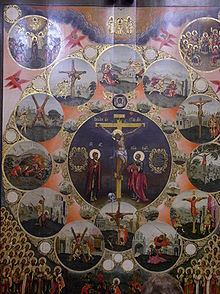
Martin Luther wrote, "The Passion of Christ should not be acted out in words and pretense, but in real life." Despite this, sung Passion performances were common in Lutheran churches right from the start, in both Latin and German, beginning as early as Laetare Sunday (three weeks before Easter) and continuing through Holy Week. Luther's friend and collaborator Johann Walther wrote responsorial Passions which were used as models by Lutheran composers for centuries, and "summa Passionis" versions continued to circulate, despite Luther's express disapproval. Later 16th-century passions included choral "exordium" (introduction) and "conclusio" sections with additional texts. In the 17th century came the development of "oratorio" passions which led to J.S. Bach's Passions, accompanied by instruments, with interpolated texts (then called "madrigal" movements) such as sinfonias, other Scripture passages, Latin motets, chorale arias, and more. Such settings were created by Bartholomeus Gesius and Heinrich Schütz. Thomas Strutz wrote a passion (1664) with arias for Jesus himself, pointing to the standard oratorio tradition of Schütz, Carissimi, and others, although these composers seem to have thought that putting words in Jesus’ mouth was beyond the pale. The practice of using recitative for the Evangelist (rather than plainsong) was a development of court composers in northern Germany and only crept into church compositions at the end of the 17th century. A famous musical reflection on the Passion is Part II of Messiah, an oratorio by George Frideric Handel, though the text here draws from Old Testament prophecies rather than from the Gospels themselves.
The best known Protestant musical settings of the Passion are by Johann Sebastian Bach, who wrote several Passions, of which two have survived, one based on the Gospel of John (the St John Passion), the other on the Gospel of Matthew (the St Matthew Passion). His St Mark Passion was reconstructed in various ways. The Passion continued to be very popular in Protestant Germany in the 18th century, with Bach's second son Carl Philipp Emanuel composing over twenty settings. In the 19th century, with the exception of John Stainer's The Crucifixion (1887), Passion settings were less popular, but in the 20th century, they have again come into fashion. Two notable settings are the St. Luke Passion (1965) by Polish composer Krzysztof Penderecki and the Passio Domini Nostri Jesu Christi secundum Joannem (1982) by Estonian composer Arvo Pärt. Recent examples include The Passion According to St. Matthew (1997), by Mark Alburger, and The Passion According to the Four Evangelists, by Scott King. Andrew Lloyd Webber's Jesus Christ Superstar (book and lyrics by Tim Rice), and Stephen Schwartz's Godspell both contain elements of the traditional passion accounts. See also Passion cantata.
Passion drama and processions

Non-musical settings of the Passion story are generally called Passion plays; these have been very widely performed in traditionally Catholic countries, often in churches as liturgical dramas - for versions with musical settings, see the previous section. One famous cycle is performed at intervals at Oberammergau Germany, and another in the Brazilian state of Pernambuco uses what is considered the largest open-air theater in the world. The Passion figures among the scenes in the English mystery plays in more than one cycle of dramatic vignettes. In the Chester Mystery Plays' portrayal of Christ's Passion, specifically his humiliation before his sentence to crucifixion, the accounts of the Gospels concerning the physical violence visited on Jesus during his trial before the Sanhedrin, and the humiliating crowning of thorns visited upon him in Pilate's palace (or by Herod's soldiers, according to Luke), is further confused by showing both actions as being carried out by jeering Jews.[32]
Processions on Palm Sunday commonly re-enact to some degree the entry of Jesus to Jerusalem; traditional ones often using special wooden donkeys on wheels. Holy Week in Spain retains more traditional public processions than other countries, with the most famous, in Seville featuring floats with carved tableaux showing scenes from the story.
There have also been a number of films telling the passion story, with a prominent recent example being Mel Gibson's The Passion of the Christ. A tradition linked to icons of Jesus holds that Veronica was a pious woman of Jerusalem who gave her kerchief to him to wipe his forehead. When he handed it back to her, the image of His face was miraculously impressed upon it.
Other traditions
- The sons of Simon of Cyrene are named as if they might have been early Christian figures known to Mark's intended audience (Brown et al. 628). Paul also lists a Rufus in Romans 16:13.
- Most garments of the region were made of woven strips of material that were about eight inches wide and included decorative braids from two to four inches (102 mm) wide. The garments could be disassembled and the strips of cloth were frequently recycled. A single garment might hold sections of many different dates. However, in Damascus and Bethlehem cloth was woven on wider looms, some Damascene being 40 inches (1,000 mm) wide. Traditional Bethlehem cloth is striped like pajama material.[33] It would thus appear that Jesus' "seamless robe" was made of cloth from either Bethlehem or Damascus.
See also
Notes
- ^ Template:StrongGreek
- ^ Webster's New World College Dictionary
- ^ Matthew 26:3–5
- ^ Mark 14:1
- ^ Luke 22:2–5
- ^ John 18:3
- ^ Luke 22:52
- ^ Matthew 26:48
- ^ Mark 14:43
- ^ Luke 22:63
- ^ John 18:22
- ^ Matthew 26:67
- ^ Matthew 27
- ^ Luke 23:8–12
- ^ Bar-abbas means son of Abbas, the Lord. Some manuscripts of Matthew say Jesus Barabbas, suggesting that an early version of the story contrasted the fate of two men both named Jesus.
- ^ The meaning of Golgotha is "place of a skull".
- ^ Bible gateway Luke 23:26
- ^ The original Greek of the Gospels reads Ἰησοῦς ὁ Ναζωραῖος ὁ Bασιλεὺς τῶν Ἰουδαίων, "Jesus the Nazarene, King of the Jews".
- ^ Mark reports Jesus said Eloi, Eloi, lama sabachthani? in Aramaic; Matthew reports Eli, Eli....
- ^ Miller 403. This is the passage that was condemned as possibly leading to Docetism.
- ^ a b Miller 403
- ^ Brown 11
- ^ Brown 140
- ^ Today's Missal: Holy Week - Pentecost, March 14 - May 17, 2008, Oregon Catholic Press
- ^ Sokolof, Archpriest D. (1962). "A Manual of the Orthodox Church's Divine Services" (Document). Jordanville, N.Y.: Holy Trinity Monastery. p. 35.
{{cite document}}: Cite has empty unknown parameters:|editor-link=,|isbn=,|volume=,|editor-first=,|url=,|edition=,|editor-last=,|accessdate=, and|contribution=(help); Unknown parameter|publication-date=ignored (help); Unknown parameter|series=ignored (help) - ^ Catholic Encyclopedia http://www.newadvent.org/cathen/12775a.htm
- ^ Catholic Encyclopedia http://www.newadvent.org/cathen/12620a.htm
- ^ Joseph P. Christopher et al., 2003 The Raccolta St Athanasius Press ISBN 978-0970652669
- ^ Ann Ball, 2003 Encyclopedia of Catholic Devotions and Practices ISBN 087973910X
- ^ Miserentissimus Redemptor Encyclical of Pope Pius XI [1]
- ^ Vatican archives http://www.vatican.va/holy_father/john_paul_ii/letters/2000/documents/hf_jp-ii_let_20001021_riparatrici_en.html
- ^ "The Chester Cycle Play XVI (16) - The Passion of Christ - Annas and Caiphas". From Stage to Page. 2007. Retrieved 2010-03-28.
- ^ Powerhouse Museum, Sydney, exhibition notes
References
- Brown, Raymond E. An Introduction to the New Testament Doubleday 1997 ISBN 0-385-24767-2
- Brown, Raymond E. et al. The New Jerome Biblical Commentary Prentice Hall 1990 ISBN 0-13-614934-0
- Kilgallen, John J. A Brief Commentary on the Gospel of Mark Paulist Press 1989 ISBN 0-8091-3059-9
- Miller, Robert J. Editor The Complete Gospels Polebridge Press 1994 ISBN 0-06-065587-9
